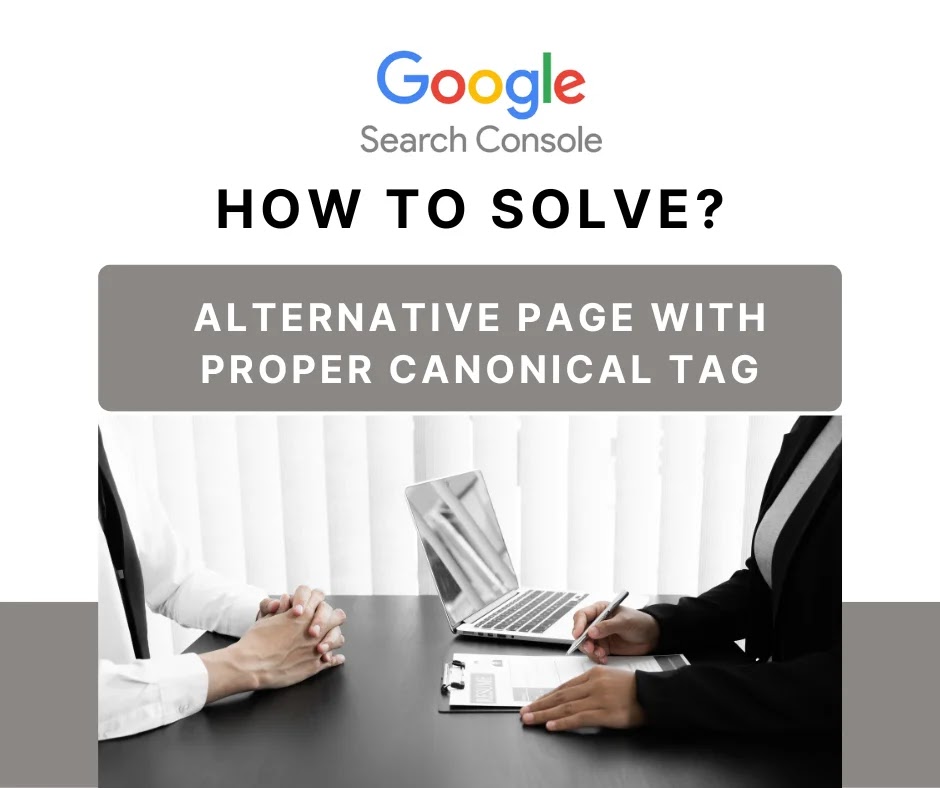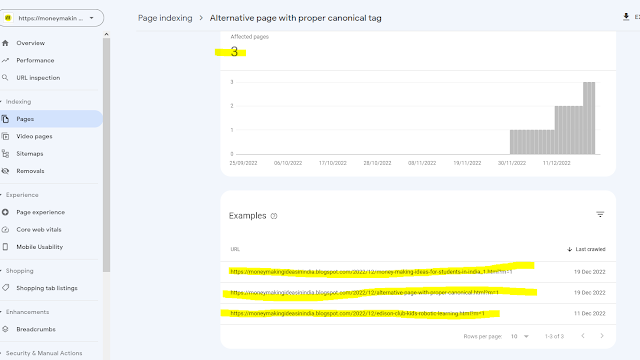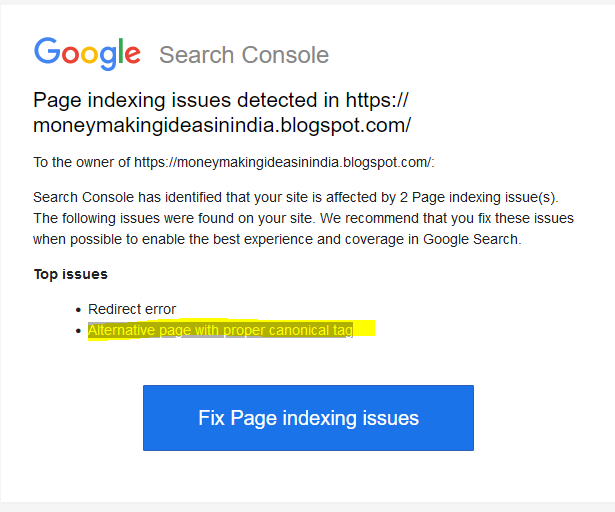Today we will see how to fix alternate page with proper canonical tag in blogger. First we should understand what is actually canonical tag. So we understand proper canonical tag and what is alternate page? One peg next to another. We can understand Alternate Page but it is more important to understand what is canonical tag. Our topic today is about this important topic.
This issue in your website or blog here. If you add your blog or website to Google search console, if there is any problem with your website, google search console will show you that. Canonical tag is one of those many problems. We are going to see detailed information about how to solve this problem and what problems it can cause.
If your website is in blogspot then you can get this error. I have to write about this on the request of many people. So let's know what is this problem and what is canonical tag and how can we solve this problem?
You have to login to google search console. After you login to Google Search Console with your Gmail account, you will see the search console dashboard. On that dashboard we have to click on >>Pages under >>Indexing tab. In this place
Why pages aren't indexed
Pages that aren't indexed can't be served on Google
Such message will be. Reasons for not indexing the page at that place, its source, validation, trend and number of pages are given. Below this we get to see the error "Alternative page with proper canonical tag" in the reason.
So now let's see what is canonical tag? When Google crawls, it understands that your blog or website has the same content and other URLS. Then he finds duplicate content on other pages on his own website. Then Google gets confused and gives the error "canonical tag". That is, when the same content is found on other pages, Google does not know exactly who this content belongs to. Due to the appearance of this same content, Google gives us a canonical tag error.
Often your website or blog
- http://www.
- https://www.
- http://
- https://websiteorblog.com/index.php
- https://websiteorblog.com/index.php?r...
- http://websiteorblog.com/index.php
- http://websiteorblog.com/index.php?r...
The same webpage opens in different formats. At that time Google Crawl gets confused. He sees the same matter on many of these urls. Actually all these URLS are same. Because they appear different, its matter is the same. But Google Crawl considers it as a duplicate. In this, if someone has stolen your content, you may get this error. Because even though the url is different, the content still shows the same.
So we don't really know who is true and who is false. Google gets confused by the calculation of duplicate content and it gets confused as to which content to crawl. So what do we need to do now? First let us define canonical. That means we have to define what is the master piece of this content.
That means if any other url is seen by google then google will not index that url. Now you know that this is a complicated part. And if we want to get out of this, we have to prove to google that one of the urls of our content is a master piece.
Once you define the canonical tag, Google will make a master copy of it. That means it will assume only the url which we have defined canonical tag.. It will not assume the rest of the urls and will not crawl either.
So now we are going to solve this. Now go back to google search console
In dashboard >> coverage >> click on "Alternative page with proper canonical tag" tag.
Now let's look at one of the URLs in the list that will appear in front of you.
In the following photo you can see that 3 pages are showing effected.
https://moneymakingideasinindia.blogspot.com/2022/12/money-making-ideas-for-students-in-india_1.html?m=1
https://moneymakingideasinindia.blogspot.com/2022/12/alternative-page-with-proper-canonical.html?m=1
https://moneymakingideasinindia.blogspot.com/2022/12/edison-club-kids-robotic-learning.html?m=1
- Let's go to your blogger dashboard
- We have to click on Theme >> Customize >> HTML.
- Now we need to find the <head> tag in the theme code.
- Just below the <head> tag
- Put this Link <link href='https://moneymakingideasinindia.blogspot.com/' rel='canonical'/>
- We have to paste this code. and to save the file.
-
<link href='https://moneymakingideasinindia.blogspot.com/' rel='canonical'/> this code is very important to put in <head> </head> tag.
This code will protect your website.
So we have defined canonical. Related to this, even if the matter in the urls appears duplicate, your website will be ranked.
Now that we have defined the canonical tag, our "Alternative page with proper canonical tag" problem has been solved. After two-three days, if you come to google search console and see, you will notice that this error is gone.
Alternative page with proper canonical tag This error probably occurs on blogspot. Google found something on blogspot that caused this error. So let's know what is this "Alternative page with proper canonical tag" error.
This is not a big mistake. We can also take some measures to remove this error. In this article we are going to see why this error occurs and what is the right solution for it.
So friends this error is probably due to duplicate pages. This means that Google has come to know that two or more pages on your blog are similar. Even if duplicate pages are found then those pages have been properly canonicalized. So you don't need to worry much.
For seo such an error indicates a different problem. Therefore, this problem should be recognized in time and this error should be removed. While doing SEO, we should always be careful not to duplicate content as well as our pages, right? Another reason could be that there might be some error in your blog's internal linking. So you should improve the internal linking in your blog articles. Google has found something wrong while crawling your pages. So Google is giving this error while crawling the pages of your blog.
Try this solution to get rid of this error
1. Check if all the pages of your blog are officially organized
What does officially mean? And how to check if blogspot pages are officially correct? So friends we should go to "Coverage > Alternate page with proper canonical tag" page. Check if these pages are indexed. If not, they should be listed properly. If you find such pages on your blog, you should canonicalize them first. Only after canonicalized we have to go to next page. That is, update the canonicalized link and move to the next step
2. Check internal link structure..
Friends, this error internal link structure can also occur in children. So make sure your pages are canonicalized properly. Check your blog pages and their URLs. See if you can find some URLs with AMP pages, page variants and UTM tags. If your URL and page structure are all correct, skip to the next step. If the internal link structure of your blog is good then it is good. And if the internal link structure of your blog is not correct then correct it in time.
We can also get this type of error due to page variant overload. That means if you are listing different versions of the same product on an ecommerce site, the sameness can creep into your pages. So see if you create a t-shirt page on your ecommerce site. At such times we do not sell single t-shirts. We sell different types of t-shirts. We sell T-shirts of different colors. We sell t-shirts of different sizes. We create different quality t shirt pages and make them live. Chances are then that Google will naturally see all those pages as the same. But those pages are not the same. There is a small change in it. But Google detects the similarity on that page without noticing that small change. That's why this error can occur.
Similarly, your ecommerce website has many products. We will produce many varieties of all those products. And such error is likely to appear on all those pages. So few of those pages can generate organic traffic. Decide whether to close by dropping the rest of the banana #. You can close it for search engines by using # tag in your url.
Rogue UTM tags
Main navigation, sidebar, footer or in the body content can also cause this type of error. Even if the code is slightly tampered with, this error can occur. This error is also harmful for your analytics data. Analytics data can hide information. So let contentKing know about your blog. That means all the urls of your blog will be explored fairly. And you can fetch detailed pages of your site in sitemap. ContentKing clears the whole picture of your site. It makes it easier for us to make decisions.
ContentKing and Google Search Console can be compared. ContentKing makes it very easy to filter your blog's URLs. So we should take help of ContentKing to filter our URLs
Check the robots.txt file. Check if there is a problem with the crawl budget. Note the URLs you don't recognize. If your website or blog has thousands of pages, many unknown pages will link to you. Such pages or links are annoying. Therefore, for websites or blogs with more pages, crawl budget issues should be considered. If you want to prevent robots from crawling such pages. txt file should be used.
In this way, we have given brief information about how the Alternative page with proper canonical tag error occurs and how to get rid of it. Visit our blog for more such information.
If you are using a blog or a website and you are getting the error Alternative page with proper canonical tag on your blog or website and you want to solve this error then read this article completely. What is the problem? Why Google Search Console is giving us this error.
What is a canonical page?
A canonical page is the preferred version of a web page, as designated by the website owner. The canonical page is the one that is indexed by search engines and is the authoritative page for a given piece of content.
If you see the status message "Alternate Page with Proper Canonical Tag" in Google Search Console, it means that there are two versions of a page on your website with the same canonical URL. Google will exclude the duplicate version and index the main version of the page. This problem can be solved by taking the following steps:
Add a canonical tag to the duplicate page that points to the main page. 301 redirect the duplicate page to the main page. Remove the duplicate page from your site.
If you need help fixing this issue, feel free to contact us and we'd be happy to help! alternate page with proper canonical tag amp The “Alternate Page with Proper Canonical Tag” status message in Google Search Console means that there are two versions of a page on your website that have the same canonical URL. To fix this, simply exclude the duplicate version and index the main version of the page.
How to Fix "Alternate page with proper canonical tag" error?
If you see the "Alternate page with proper canonical tag" error in your Google Search Console, it means that one or more of your pages is pointing to another page with a rel="canonical" link tag. This is usually an innocent mistake, but it can cause problems with your site's SEO.
To fix this error, simply look for the rel="canonical" link tag on the offending page and remove it. If you're not sure which page is causing the problem, you can use the "Fetch as Google" tool in Google Search Console to fetch the pages in question and see which one is returning the canonical link tag.
Should every page have a canonical tag?
Every page should have a canonical tag if you want search engines to index that page.
Make sure to include a canonical tag on every page of your website. This will help prevent any duplicate content issues and make sure that all your pages are properly indexed. Even if there is only one version of a particular page, be sure to include a canonical tag that points to that page.This will help ensure that search engines can index your content properly. It is important to have well-indexed content so that people can easily find it when they are searching for specific topics.Thanks for everything!
How do you fix the specified canonical link points to a different page?
If you are trying to fix the specified canonical link points to a different page, you will need to change the URL in the code. If you want to fix this error, you'll need to replace the redirect URL with a canonical tag on the page. This way, the page will be crawlable and appear in the search engine index. Keep in mind that you must use the canonical tag on the version of the page that returns server response code 200 (OK).
There are a few ways to check if a page has a canonical tag. One way is to view the source code of the page and look for the canonical URL. Another way is to use a tool like Screaming Frog SEO Spider to crawl the website and check for the canonical tag.
You can check if a page has a canonical tag by viewing the page's source code. If a canonical tag is present, it will be located in the <head> element.
To view the page source, right-click on your webpage. Press Control + F and search for "canonical." Make sure that the URL part of href= is the URL of the page you would like to be indexed.
Do canonical tags affect SEO?
Yes, canonical tags affect SEO.A canonical tag is an HTML element that helps webmasters avoid duplicate content issues on their websites. Canonical tags indicate to search engines which version of a page is the original, or "canonical," version. Canonical tags can influence SEO in several ways. For example, they can affect how search results are displayed. They can also indirectly influence a website's rankings, due to factors such as site structure, user experience and PageRank flow.
Are canonical URLs bad for SEO?
Canonical URLs are not bad for SEO. In fact, they can be helpful in some cases. For example, if you have two URLs that point to the same content, using a canonical URL can help avoid duplicate content issues. Duplicate content is a serious problem for search engine optimization. When you have identical or similar content on multiple URLs, it can cause indexing issues. This can also dilute your link equity, which could hurt your search rankings.
How do I fix canonical issues?
There is no single answer to this question since the solution will vary depending on the specifics of the issue. However, some potential solutions include using 301 redirects, setting up rel="canonical" tags, or using the Google Search Console tool to submit corrected URLs. There are two primary methods for resolving canonical issues: using 301 redirects and/or adding a “canonical” tag to your pages.
What is canonical tag example?
The canonical tag is an HTML element that helps webmasters prevent duplicate content issues.. It is an indication to search engines that a specific URL represents the master copy of a page. For example, if you have a page located at http://example.com/product.html, and another page at http://example.com/product.htm, you can use the canonical tag to indicate that http://example.com/product.html should be considered the master copy.
The canonical tag should be placed in the <head> section of the page, and should look like this:
<link rel="canonical" href="http://example.com/product.html">
This tells the search engines that the URL http://example.com/product.html is the canonical (master) version of the page, and that they should index that page instead of any duplicates.










0 Comments